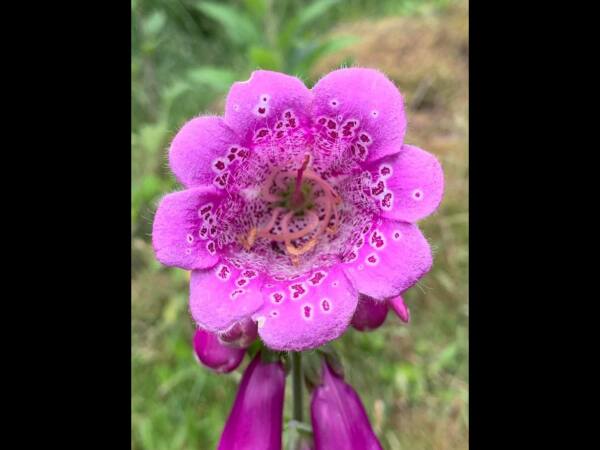| Blogs > sparkleflit > My Blog |
|
FOXGLOVE MUTATION...... These Foxglove flower mutations have been showing up on the island this year, We haven't seen anything like them before......    |
|||
|
We are seeking answers.....anyone here seen this before?
| ||
|
Have foxglove in garden but never seen before either. Found the following information courtesy google below, the keyword being peloria. The botanical name for this foxglove is digitalis purpurea monstrosa (monstrosa Greek term meaning huge/monstrous) which forms peloric flowers. Pelorism normally found in plants with bilateral symmetry such as snapdragon, gloxinia. Expression of what causes peloric gene not clear but the environment is referenced by several people. It could be a decrease in light, or unusual temperatures, indicating an epigenetic effect.
| ||
|
I can't explain it, but they are sure lovely! It's like two different colors bred together and had speckled offspring. I assume they are growing wild on your island? What a beautiful wonderland you inhabit. Be a prism, spreading God's light and love, not a mirror reflecting the world's hatred.
| ||
|
Have foxglove in garden but never seen before either. Found the following information courtesy google below, the keyword being peloria. The botanical name for this foxglove is digitalis purpurea monstrosa (monstrosa Greek term meaning huge/monstrous) which forms peloric flowers. Pelorism normally found in plants with bilateral symmetry such as snapdragon, gloxinia. Expression of what causes peloric gene not clear but the environment is referenced by several people. It could be a decrease in light, or unusual temperatures, indicating an epigenetic effect.
| ||
|
I can't explain it, but they are sure lovely! It's like two different colors bred together and had speckled offspring. I assume they are growing wild on your island? What a beautiful wonderland you inhabit.
| ||
|
So what I have found out is that Pelorism in Foxgloves has appeared at least since 1907.......It is always and only the topmost flower that develops this mutation. Usually, the flowers develop from the bottom to the top, but in this case, the mutated, topmost flower develops first....... Darwin was fascinated by these Peloric Foxgloves and did experiments, but was hindered by their biennial nature. I also found that there have been Peloric Foxgloves bred on purpose, so I wonder if someone on the island planted a mutation and the pollinators spread it to the wild flowers......
| ||
|
There are acres of Foxgloves in some places on the island.....many along the side of roads.....they grow wild along the edges of our property, they are biennials......We have our local biologists working on it ....One of them is my daughter's best friend since grade 1....she's a butterfly expert....she thinks it may be over-pollination...There are more bees and butterflies this year than we remember ever seeing..... Be a prism, spreading God's light and love, not a mirror reflecting the world's hatred.
| ||
|
There are acres of Foxgloves in some places on the island.....many along the side of roads.....they grow wild along the edges of our property, they are biennials......We have our local biologists working on it ....One of them is my daughter's best friend since grade 1....she's a butterfly expert....she thinks it may be over-pollination...There are more bees and butterflies this year than we remember ever seeing.....
| ||
|
Quite a long read from a gardener at Kew but it explains the nature of Pelorism as a spontaneous mutation which is produces a fertile plant and the fertile mutation can then be passed on through a recessive gene. In June last year, I noticed a strange flower among a group of foxgloves (Digitalis purpurea) near the Japanese Minka House in the Royal Botanic Gardens, Kew. It was an example of 'terminal peloria', a well-known floral genetic mutation that occurs spontaneously – but infrequently – in nature. I always look out for this lovely mutant when I see a group of foxgloves. Most of the flowers appear normal, but there is a huge bowl-shaped terminal flower that opens before the other flowers, despite being located above them. The terminal flower is radially symmetrical and appears to be composed of a ring of spotted petals somehow stitched together. Peloric flowers are radially symmetrical flowers that occur in species with normally bilateral flowers – species such as foxgloves, mints, orchids or snapdragons that have a single plane of symmetry. Linnaeus was fascinated by a mutant of common toadflax (Linaria vulgaris) with radially symmetrical flowers, which he termed "Peloria", after the Greek word for monster. In his Linaria mutant, as in most genetic flower mutants, all the flowers were abnormal. In contrast, in this particular mutant of Digitalis, only the terminal flower is different, so the location of the flower on the plant is significant. Normally, foxgloves have indeterminate inflorescences, which means that the apex of the flower spike continues to produce flowers until it becomes exhausted, sometimes achieving a considerable height in a single flowering season. However, in the mutant plant with terminal peloria, the flower stalk is terminated by the strange abnormal "bell-flower", which means that no further flowers could be produced. This terminal flower mutant, sometimes called Digitalis purpurea monstrosa, has been described by botanists from the mid-nineteenth century onwards. For example, Masters (1869) documented this phenomenon in his book on Vegetable Teratology, itself a broad topic that fascinated early botanists. Breeding experiments have shown that the terminal flower mutation in Digitalis is inherited as a simple Mendelian recessive, and can be reproduced from seed via either the peloric or normal flowers of the same plant, which are all fertile). Mutations that can be inherited and reproduce by seed could theoretically be capable of establishing new plant lineages, and would therefore be "hopeful monsters" (Goldschmidt, 1940) or "prospecies" (Bateman & DiMichele, 2002). Why are peloric flowers and other types of flower mutation apparently so common in plant groups such as orchids on the one hand and foxgloves and their relatives on the other? At least in part, the answer is that abnormalities are much more obvious in these groups with showy flowers that so obviously possess a single plane of symmetry, compared with the radial symmetry of most other flowers. However, terminal flower mutations can also occur in plants with radially symmetric flowers. For example, in some species of the coffee family, Rubiaceae, there are cases reported of inflorescences in which the lateral flowers all have four petals and the single terminal flower has five petals. Thus, it always pays to keep your eyes open to look for the exceptions; indeed, it can become almost an obsession. It's useful to know that in the modern molecular era, detailed records of spontaneous heritable abnormalities– some dating from the earliest days of natural history – can still contribute significantly to our understanding of evolution.
| ||
|
Quite a long read from a gardener at Kew but it explains the nature of Pelorism as a spontaneous mutation which is produces a fertile plant and the fertile mutation can then be passed on through a recessive gene. In June last year, I noticed a strange flower among a group of foxgloves (Digitalis purpurea) near the Japanese Minka House in the Royal Botanic Gardens, Kew. It was an example of 'terminal peloria', a well-known floral genetic mutation that occurs spontaneously – but infrequently – in nature. I always look out for this lovely mutant when I see a group of foxgloves. Most of the flowers appear normal, but there is a huge bowl-shaped terminal flower that opens before the other flowers, despite being located above them. The terminal flower is radially symmetrical and appears to be composed of a ring of spotted petals somehow stitched together. Peloric flowers are radially symmetrical flowers that occur in species with normally bilateral flowers – species such as foxgloves, mints, orchids or snapdragons that have a single plane of symmetry. Linnaeus was fascinated by a mutant of common toadflax (Linaria vulgaris) with radially symmetrical flowers, which he termed "Peloria", after the Greek word for monster. In his Linaria mutant, as in most genetic flower mutants, all the flowers were abnormal. In contrast, in this particular mutant of Digitalis, only the terminal flower is different, so the location of the flower on the plant is significant. Normally, foxgloves have indeterminate inflorescences, which means that the apex of the flower spike continues to produce flowers until it becomes exhausted, sometimes achieving a considerable height in a single flowering season. However, in the mutant plant with terminal peloria, the flower stalk is terminated by the strange abnormal "bell-flower", which means that no further flowers could be produced. This terminal flower mutant, sometimes called Digitalis purpurea monstrosa, has been described by botanists from the mid-nineteenth century onwards. For example, Masters (1869) documented this phenomenon in his book on Vegetable Teratology, itself a broad topic that fascinated early botanists. Breeding experiments have shown that the terminal flower mutation in Digitalis is inherited as a simple Mendelian recessive, and can be reproduced from seed via either the peloric or normal flowers of the same plant, which are all fertile). Mutations that can be inherited and reproduce by seed could theoretically be capable of establishing new plant lineages, and would therefore be "hopeful monsters" (Goldschmidt, 1940) or "prospecies" (Bateman & DiMichele, 2002). Why are peloric flowers and other types of flower mutation apparently so common in plant groups such as orchids on the one hand and foxgloves and their relatives on the other? At least in part, the answer is that abnormalities are much more obvious in these groups with showy flowers that so obviously possess a single plane of symmetry, compared with the radial symmetry of most other flowers. However, terminal flower mutations can also occur in plants with radially symmetric flowers. For example, in some species of the coffee family, Rubiaceae, there are cases reported of inflorescences in which the lateral flowers all have four petals and the single terminal flower has five petals. Thus, it always pays to keep your eyes open to look for the exceptions; indeed, it can become almost an obsession. It's useful to know that in the modern molecular era, detailed records of spontaneous heritable abnormalities– some dating from the earliest days of natural history – can still contribute significantly to our understanding of evolution.
| ||
|
Perhaps the coronavirus lockdown could explain the resurgence of butterflies and butterflies because roadside borders haven't been maintained by local councils/left undisturbed - roadside borders apparently one of the last refuges left for many plant species. Perhaps the current wildflower riot and pollinators have brought about the foxglove mutations or perhaps they were privately cultivated and then spread as you suggested?
|
×
×




